Puglia is poor. Driving from north to south, we witnessed grim estates on the outskirts of Brindisi, derelict buildings by the score and lots of litter. But the sun was shining and bushes bursting with colourful flowers lined the pot-holed motorway.
The city of Lecce’s suburbs were as ropey as Brindisi’s but it was the historic heart of the city that was our goal. Driving around it was horribly stressful and it took two attempts to locate our posh hotel, the Patria Palace, thanks to the narrow streets, ‘no entry’ signs and a stroppy local, angry with us for daring to take our car into the centro storico. We ended up parked by the monstrous Porta Napoli, me in a thunderous mood. It was only after we’d checked in and sorted other problems – the TV (far too complex, too many channels) and the safe (should’ve ignored the instructions) – that I was able to wind down.
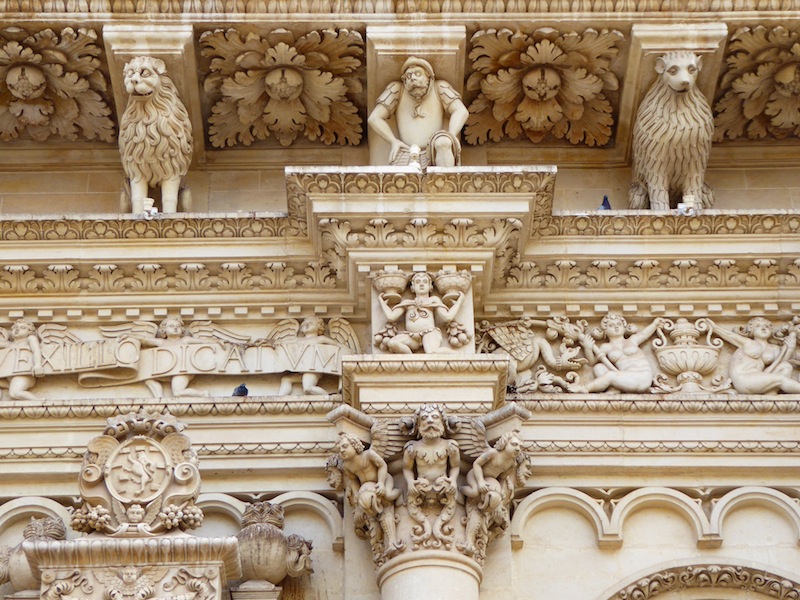
Lecce is a baroque masterpiece but it’s a very specific style of baroque. Maestros like Giuseppe Zimbalo and a host of other artists took advantage of the easily carved limestone that’s particular to the region and the result is a city that’s florid and wildly over-the-top. A walk around the centre brings to mind a wedding cake on steroids.
Churches, palazzo and government buildings are by far the most extravagant but even some of the more modest buildings have outrageously flamboyant touches, as if they’re competing for attention with their neighbours. We quickly realised that Lecce was one of those cities you have to walk around with your neck craned, eyes to the sky. The Church Of St Teresa with its truncated facade and the swirling grandeur of the Church of St Matteo were among the stars.
But Lecce is not as perfect as Florence. The poverty of Puglia seeps into the city’s streets and there are obvious signs of decay. While there’s been a lot of restoration, there are still derelict structures in the back streets awaiting a saviour. Badly pitted stones worn away by centuries of rain and pollution can be seen on most buildings and others bear scars where rendering has collapsed. However, this shabbiness, while a bit worrying, does add a certain charm to the city and at least means it doesn’t look like a Disneyfied re-creation.

We started our walk in the heat and sunshine of Piazza Sant’Oronzo, a generous open space dominated by two particularly imposing monuments. The Colonna di Sant’Oronzo features the city’s patron saint atop a column, which originally stood in Brindisi and once marked the end of the Via Appia, the old Roman road that began in Rome.
Beside it are the remains of the Roman Amphitheatre, dating from the 2nd century but only excavated in the early 20th. Just a section of it is visible – the rest is under 2,000 years of subsequent development – and it wasn’t possible to go down into its guts to get a feel for it. However, it’s still used for events.
The Piazza del Duomo proved to be an even greater revelation. Turning off the busy main thoroughfare, the Corso Vittorio Emanuele II, we were unexpectedly confronted with a gigantic open space, almost devoid of people, but lined with the most extraordinary baroque buildings.
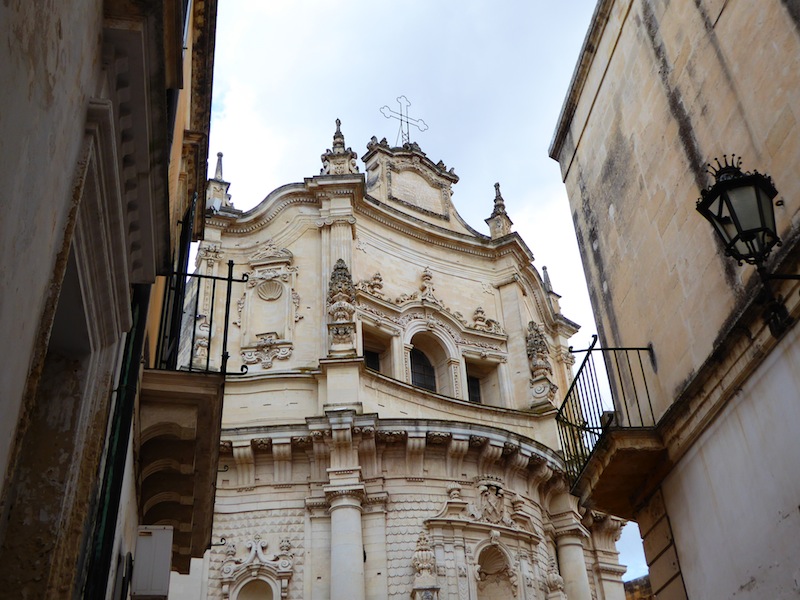
Ahead of us was the 12th century cathedral, which Zimbalo did much to adorn and that boasts not one but two extravagant facades. Next to it, the 68m bell tower, another of Zimbalo’s masterpieces, the bishop’s palace and a seminary. Hoping to see some state rooms, we paid to go into the diocesan museum in the seminary building but instead found a couple of rooms full of dreadfully morbid religious art and artefacts. We looked at each other in horror because there are few things we loathe more. However, a keen guide showed us around and her enthusiasm and the stories she told made it marginally more bearable. When some other visitors arrived and she marched off to welcome them, we made a hurried exit.
The most extravagant example of Lecce Baroque is reserved for the Basilica di Santa Croce, which was over the road from our hotel. Although parts of the frontage were covered in scaffolding, we could still make out the creatures and characters that Zimbalo and his artists carved into the manic frontage of the church during the 16th and 17th centuries. The Renaissance interior was impressive too. Nextdoor, the Palazzo del Governo was another of the city’s more attractive piles.
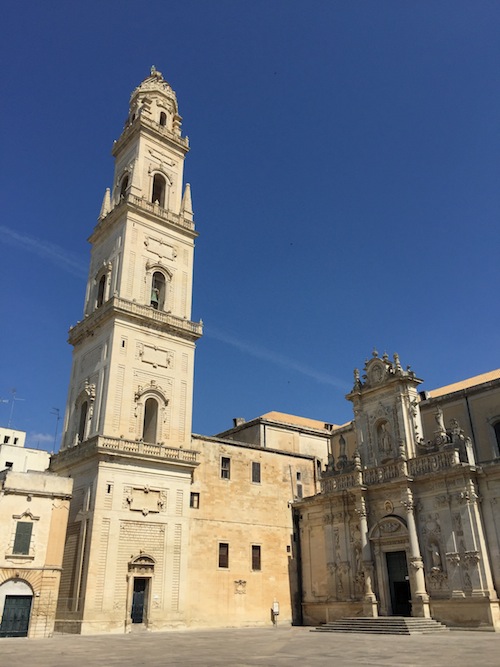
Lecce’s museums are more of a mixed bag. The star of the show was the Museo Faggiano in Via Ascanio Grandi, an extraordinary house that reveals layer upon layer of the city’s history. The stories were revealed when the owner, who was hoping to open a trattoria in the property, started digging to find out why his toilet pipe kept getting blocked.
The family ended up unearthing a Messapian tomb, a Roman granary, a Christian chapel and evidence of the Knights Templar occupation, as well as large quantities of pottery and other detritus from 2,000 years of human habitation. It was fascinating and at times claustrophobic as we clambered down into cisterns and tombs amid the old tiling, drainage systems and architectural details of the building. Up on the roof, we watched as a storm rumbled around the outskirts of the city.
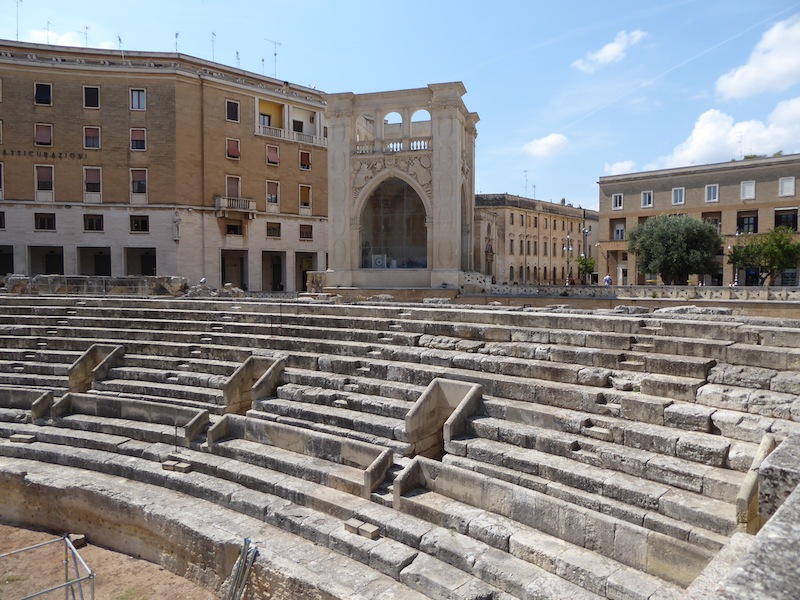
The bonkersly named Museo Provinciale Sigismondo Castromediano on the edge of the historic district was packed with artefacts from Lecce and Puglia, a vast collection from pre-history to Roman, Greek and more recent eras. But it was as dry as a bone and there was little in the way of English translation. It was one of those museums that weigh you down with the sheer number of artefacts and succeed only in sucking the life out of a potentially interesting subject.
The Teatro Romano Museum was tacked on to the remains of the old Roman theatre. The literature was good, we saw slabs from the Via Appia and there was a good model of the theatre as it would’ve looked in its heyday, but the theatre itself was neglected. The previous night it had hosted a concert and nobody had bothered to collect up the chairs, empty water bottles and other rubbish. Wild, mangy cats roamed around and I stumbled across the dried up remains of a dead one. We tried to ignore the rubbish and sat in the sun, picking out the history of the site in the remaining architecture.
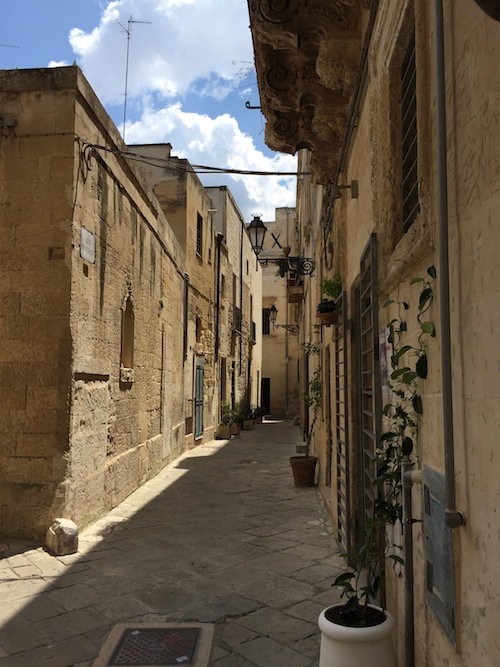
Our final museum stop was at the Palazzo Taurino, which highlighted the history of Jewish occupation of the district around the Basilica di Santa Croce. There was plenty to read but not a huge amount to see amid the building’s cellars, which was a bit disappointing.
Of an evening, Lecce was full of life – a lot busier than our other stops in Puglia. And that was no doubt owing to the number of students from the city’s university, who could often be seen hanging around the cafes of Piazza Sant’Oronzo.
We stopped mostly in the bars and restaurants around Piazza Vittorio Emanuele II and on Corso Vittorio Emanuele II, where we could sit outside on the warm evenings and watch the world go by. There were a surprising number of looky looky men and women selling their wares and lots of good wine and prosecco to be drank. A place called 00 was a particular favourite.
We left Lecce on a steamy morning, saying goodbye to a city that had delivered beautiful sights and great nightlife in spades. It’s a city I’d recommend to anyone.

